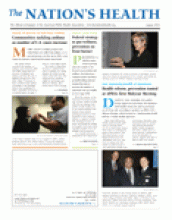Despite the American public’s strong support for prevention, the landmark 2010 health reform law and its provisions are far from safe, according to speakers at APHA’s 2011 Midyear Meeting, which focused on “Implementing Health Reform: A Public Health Approach.”

Lawrence Wallack, DrPH, dean of the College of Urban and Public Affairs at Portland State University, at left, speaks with attendees at APHA’s 2011 Midyear Meeting in Chicago.
Photo by Michele Late
More than 600 public health professionals gathered in Chicago June 23–25 to learn more about their roles in realizing the goals of the historic law, officially known as the Patient Protection and Affordable Care Act, and how to ensure the law results in both access to care and better health and well-being. Attendees also discussed ways to protect and defend threatened public health programs and were called upon to help educate communities as to the benefits of reform. Signed into law in March 2010, the health reform law created the National Prevention, Health Promotion and Public Health Council as well as a $15 billion Prevention and Public Health Fund, money from which has already begun flowing to community health work.
Despite public health support, some in Congress have already tried to repeal the law entirely as well as eliminate specific provisions such as the prevention fund. Lawsuits aimed at overturning the law are making their way through the courts. However, the good news is that the public backs a national investment in preventing disease and disability. According to survey data presented by meeting speaker Celinda Lake, president of Lake Research Partners, Americans think the country is doing poorly when it comes to health and overwhelmingly support directing more resources toward community prevention.
But while the public supports prevention, they are somewhat unclear as to what community prevention efforts entail, research shows. Also, the public is very sensitive to the issue of taxes, Lake said, noting that people tend to respond more favorably to proposals that couple both community prevention and individual responsibility as well as to efforts that target children. Lake called on attendees to “define what community prevention is for people” and to frame the overall goal as making it easier for people to make the choices that result in better health.
“Public health people are good spokespersons because people trust them,” Lake told The Nation’s Health. “But they can’t be the only ones out there.”
Many speakers at the Midyear Meeting noted that the debate and controversy regarding the health reform law often has less to do with facts and figures and more with people’s beliefs regarding the role of government. Former Michigan Gov. Jennifer Granholm noted that fixing the current health system is an economic imperative as well, as soaring health insurance costs are driving U.S. employers across the borders. Describing public health professionals as “radicals,” Granholm urged them to hold policymakers accountable for the decisions that chip away at the opportunities for better health.

Jennifer Granholm, JD, former governor of Michigan, speaks about the return on investment in U.S. health care during the opening session of APHA’s Midyear Meeting in June.
Photo by Michele Late
“They need to hear you and they need to fear you,” she said.
Health reform already reaping successes
The health reform law is already resulting in prioritizing and raising awareness of prevention. June was declared the first Prevention and Wellness Month. As part of the month, the U.S. Department of Health and Human Services announced the availability of $40 million in funds from the Prevention and Public Health Fund to aid health departments in their work to address and prevent leading chronic diseases. In addition, provisions of the law are already producing positive data.
As of this summer, about 5.5 million people with traditional Medicare took advantage of one or more preventive services, such as mammograms and prostate cancer screenings, now offered at no cost thanks to the health reform law, according to Caya Lewis, MPH, chief of staff at the Centers for Medicare and Medicaid Services, who addressed the Midyear Meeting. The uptake in such services means that 16 percent of Medicare beneficiaries are seeing doctors with “timely prevention and wellness on their minds,” Lewis said during a session on public health, health care and quality. Officials are hoping to drive that number up through a new awareness campaign launched this summer.

Caya Lewis, chief of staff for the Centers for Medicare and Medicaid Services, speaks at APHA’s 2011 Midyear Meeting.
Photo by Michele Late
In addition to eliminating Medicare cost-sharing for recommended preventive services, the health reform law also eliminated any cost-sharing for the “Welcome to Medicare” exam and directed Medicare to begin offering a free annual wellness exam starting this year. According to CMS data released in June, more than 66,000 beneficiaries had taken advantage of the now-free welcome exam as of May 2011 — a 26 percent increase over May 2010. Lewis said CMS is working on ways to get the word out to Medicare patients about the new preventive benefits.
But while health reform continues to make positive inroads, many speakers noted that public health faces an uncertain future. APHA member Paul Jarris, MD, MBA, executive director of the Association of State and Territorial Health Officials, noted that the new resources from the Prevention and Public Health Fund were intended to expand investments in prevention, not supplant public health funding.
“The public health infrastructure in this country is at risk and in some places, crumbling,” he said. “(The fund) is an incredible opportunity for us, but it can slip through our fingers.”
Paul Kuehnert, MS, RN, executive director of Illinois’ Kane County Health Department, said that while the “reality is that local health departments have not yet seen these new (prevention) dollars,” the health reform law presents a number of new opportunities for local public health, such as an expanded role in Medicaid outreach and enrollment and helping residents navigate the coming state-based health insurance exchanges. Kane said that as more people become insured and fewer people depend on local health departments for direct health services, many local departments might have to restructure to survive.
Health reform poses similar threats as well as opportunities for many public health priorities. For example, the new health reform law requires that insurance plans participating in a state-based health insurance exchange cover all vaccines recommended by the national Advisory Committee on Immunization Practices with no cost sharing. The requirement could go far in filling major vaccine-related state funding cuts, said Alexandra Stewart, JD, assistant research professor at George Washington University’s School of Public Health and Health Services.
A key part of implementing the health reform law will be educating about and building support for the law’s prevention provisions, which means public health professionals must frame the conversation in a way that is relatable to both people and policymakers, according to a number of Mid-year Meeting speakers.
“Data only reaches the mind,” noted Judith Monroe, MD, MPH, deputy director of CDC’s Office for State, Tribal, Local and Territorial Support, during a session on using health reform to achieve prevention and wellness. “We have to reach both heart and mind.”
Closing session speaker Lawrence Wallack, DrPH, dean of the College of Urban and Public Affairs at Portland State University, noted that while “we believe deep down that the facts will set us free and that data will win the day,” it is not the most effective way to build support for health reform and community prevention. Instead, he called on attendees to create messages that reflect public health and social justice values.

From left, speakers at the closing session of APHA’s 2011 Midyear Meeting in Chicago: Lawrence Wallack, DrPH, dean of the College of Urban and Public Affairs at Portland State University; APHA Executive Director Georges Benjamin, MD, FACP, FACEP (E); and James Galloway, MD, FACP, FACC, FAHA, U.S. assistant surgeon general.
Photo by Michele Late
“Each of us needs to speak our values so that others understand that our well-being is rooted in the community,” Wallack said.
For more information on APHA’s Midyear Meeting, visit www.apha.org/midyear. Videos from some of the meeting’s sessions can be viewed on APHA’s YouTube channel, www.youtube.com/aphadc. For information on the health reform law, visit www.healthcare.gov.
- Copyright The Nation’s Health, American Public Health Association









